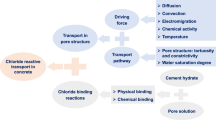Abstract
The complexity of the process of chloride penetration in concrete makes it difficult to define a standard procedure in order to calculate diffusion coefficients. In this paper, an attempt to find joint relations between coefficients calculated from different procedures is made. As a first step, an empirical relation, that allows the conversion of a diffusion coefficient calculated from any experimental conditions to a reference condition (0.5 M NaCl and 90 days of duration of the test), has been developed and validated with different natural diffusion tests. This relation enables the comparison between different non-steady-state diffusion coefficients. As a second step, the equivalence between migration and natural diffusion tests has been undertaken from different series of migration tests, in steady and nonsteady-state, conditions. The final results have been presented in a graphical form in order to facilitate their application.
Résumé
La complexité des procédures de pénétration des chlorures dans le béton rend difficile la définition d'une procédure normalisée pour le calcul des coefficients de diffusion. Cette étude tente de trouver des relations entre les coefficients de diffusion qui ont été calculés selon différentes méthodes. La première étape consiste à trouver une relation expérimentale qui permettra la conversion des coefficients de diffusion calculés selon n'importe quelle méthodologie, vers une condition de référence (0.5 M NaCl et une durée de 90 jours pour cette expérience). Cette relation rend possible la comparaison entre les différents coefficients de diffusion du régime non-stationnaire. Dans une deuxième étape, l'équivalence entre les essais de migration et de diffusion naturelle a été entreprise à partir de différents essais de migration en régimes stationnaire et non-stationnaire. Les relations obtenues ont été validées par les données de diffusion naturelle. Les résultats finaux sont présentés sous forme graphique pour en faciliter l'utilisation.
Similar content being viewed by others
References
Andrade, C., Castellote, M., Alonso, C. and González, C., ‘Non-steady-state chloride diffusion coefficients obtained from migration and natural diffusion tests. Part I: Comparison between several methods of calculation‘,Mater. Struct. 33 (January–February 2000), 21–28.
Bamfort, P. B. and Price, W. F., ‘Concrete 2000, Economic and durable construction through excellence’, (E&F Spon, Dundee), Vol. 2, September (1993), 1105–1118.
Andrade, C. and Sanjuán, M. A., ‘Experimental procedure for the calculation of chloride diffusion coefficients in concrete from migration tests’,Advances in Cement Research 6(23) (1994), 127–134.
Andrade, C., Sanjuán, M. A., Recuero, A. and Rio, O., ‘Calculation of chloride diffusivity in concrete from migration experiments in non-steady-state conditions’,Cement and Concrete Research 24(7) (1994) 1214–1228
Keister, J. C. and Kasting, G. B., ‘Ionic mass transport through a homogeneous membrane in the presence of a uniform electrical field’,Journal of Membrane Science 29 (1986) 155.
Ost, B. and Monfore, G. E. ‘Penetration of chloride into concrete’,Journal of the PCA Research and Development Laboratories (1966) 46–52.
Collepardi, M., Marcialis, A. and Turriziani, R., ‘Penetration of chloride ions into cement pastes and concretes’,Journal of American Ceramic Society (1972) 534–535.
Sorensen, B. and Maahn, E., ‘Penetration ratio of chloride in marine concrete structures’,Nordic Concrete Research 1 (December 1982).
Kawakami, H., ‘A study of chloride concentration in a reinforced concrete building with diffusion theory’,Transactions of the Japanese Concrete Institute 7 (1985) 149–156.
Buenfeld, N. R. and Newman, J. B., ‘Examination of the three methods for studying ion diffusion in cement pastes, mortars and concrete’,Mater. Struct 20 (1987) 3–10.
Mangat, P. S. and Gurusamy, K., ‘Chloride diffusion in stecl fiber reinforced concrete’,Cement and Concrete Research 17 (3) (1987) 385–396.
Jaegermann, C., ‘Effect of water-cement ratio and curing on chloride penetration into concrete exposed to Mediterranean Sea climate’,ACI Materials Joumal 87 (4) (1990) 333–339.
Seneviratne, G. A. M., ‘Role of PFA quality on transportatio and occurrence of chloride in concrete’, Doctoral Thesis, University of Dundee, Scotland, U.K., (1991).
Mangat, P. S. and Molloy, B. T., ‘Factors influencing chloride induced corrosion of reinforcement in concrete’,Mater. Struct. 25 (1992), 404–411.
Sandberg, P. and Tang, L., ‘A field study of the penetration of chlorides and other ions into a high quality concrete marine bridge column’. Proceedings of the Third CANMET/ACI International Conference on Durability of Concrete, (ACI SP-145, Nice, 1994), 557–571.
Poulsen, E., ‘Description of exposure to chloride of marine concrete structures’, Proceedings of the International RILEM Workshop, St-Rémy-les-Chevreuse, (RILEM Publications, France, 1995) 126.
Hobbs, D. W., ‘Chloride ingress and chloride-induced corrosion in reinforced concrete members’, Proceedings of the Fourth International Symposium on Corrosion of Reinforcement in Concrete Construction, SCI. Robinson College, Cambridge, U.K., (1996).
Takeda, N., Sakoda, S. and Sogo, S., ‘Penetration of chloride ions in concrete and corrosion of reinforcing bars exposed to marine environment’, Fourth CANMET/ACI international conference on durability of concrete, Sydney, Australia, (1997).
Costa, A. and Appleton, J., ‘Chloride penetration into concrete
Author information
Authors and Affiliations
Additional information
Editorial Note
Dr. Alonso is a RILEM Senior Member and participates in the work of RILEM TC 178-TMC: ‘Testing and modelling chloride penetration in concrete’.
Dr. Camen Andrade is the President of RILEM and a RILEM Fellow. She is the Chairlady of RILEM TC 178-TMC. She is also the Director of CSIC, a RILEM Titular Member.
Dr. Castellote is a member of RILEM TC 178-TMC.
Rights and permissions
About this article
Cite this article
Castellote, M., Andrade, C. & Alonso, C. Non-steady-state chloride diffusion coefficients obtained from migration and natural diffusion tests. Part II: Different experimental conditions. Joint relations. Mat. Struct. 34, 323–331 (2001). https://doi.org/10.1007/BF02486483
Received:
Accepted:
Issue Date:
DOI: https://doi.org/10.1007/BF02486483




